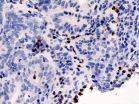(Press-News.org) (MEMPHIS, Tenn. – March 27, 2014) The quest to improve survival of children with a high-risk brain tumor has led St. Jude Children's Research Hospital investigators to two drugs already used to treat adults with breast, pancreatic, lung and other cancers. The study was published today online ahead of print in the journal Cancer Cell.
Researchers demonstrated that the drugs pemetrexed and gemcitabine killed cells from mouse and human brain tumors, called group 3 medulloblastoma, growing in the laboratory. Medulloblastoma is diagnosed in about 400 children annually in the U.S., making it the most common pediatric brain tumor. Of the four distinct medulloblastoma subtypes, patients with group 3 medulloblastoma have the worst prognosis.
Used together, pemetrexed and gemcitabine doubled life expectancy of mice with human group 3 medulloblastoma, compared to untreated mice. When pemetrexed and gemcitabine were combined with two chemotherapy drugs currently used to treat pediatric medulloblastoma, the mice lived even longer.
The drugs were identified by screening the St. Jude library of 7,389 compounds looking for ones that targeted group 3 mouse tumor cells rather than normal mouse brain cells. The library included all 830 drugs U.S. Food and Drug Administration (FDA) approval. Pemetrexed and gemcitabine emerged as the top candidates, based in part on their ability to kill group 3 medulloblastoma tumor cells at concentrations that researchers showed were safe and achievable in patients.
"Our focus was to identify drugs that we could move quickly from the laboratory to the clinic where new chemotherapy options are desperately needed for these high-risk medulloblastoma patients," said the study's corresponding author Martine Roussel, Ph.D., a member of the St. Jude Department of Tumor Cell Biology. "As a basic scientist, it is exciting to be able to translate a laboratory discovery into drugs that are now being used in a clinical trial."
Based on results from this and previous studies, pemetrexed and gemcitabine were included in a St. Jude-led multicenter clinical trial of children and adolescents newly diagnosed with medulloblastoma. The drugs are already approved for treatment of patients with advanced breast cancer as well as ovarian, pancreatic and certain lung cancers. No safety concerns were identified in previous studies of pemetrexed and gemcitabine for treatment in children with other cancers.
Most group 3 medulloblastoma tumors feature excessive levels of the c-MYC protein, which helps to regulate cell growth. The protein is overexpressed in many cancers and is associated with a poor outcome. About 40 percent of patients with c-MYC overexpression and other characteristics of group 3 medulloblastoma become long-term survivors, compared to 80 percent of other medulloblastoma patients.
"The drugs identified in this study will hopefully close that survival gap and improve cure rates for children with group 3 medulloblastoma," said co-author Amar Gajjar, M.D., St. Jude Department of Oncology co-chair.
For this study, researchers relied on mice with group 3 medulloblastoma grown from patient tumors. The mice were developed in Roussel's laboratory and are a powerful tool for testing the effectiveness of drugs against human tumors. Researchers used the mice to show that pemetrexed and gemcitabine worked against human group 3 tumors and that the drugs could be used in combination with existing chemotherapy agents to boost treatment effectiveness without undue risk. Cisplatin and cyclophosphamide were the other drugs used in this study.
"The finding provides a strong rationale for combination therapy with pemetrexed and gemcitabine for treatment of group 3 medulloblastoma," Roussel said. Researchers found no evidence that mouse tumor cells develop resistance to the drugs.
Pemetrexed works by disrupting the ability of cancer cells to proliferate. Gemcitabine kills cells by triggering their suicide pathway. Researchers also found evidence the drugs work specifically against group 3 medulloblastoma. The drugs did not extend survival of mice with a different medulloblastoma subtype.
The study builds on previous St. Jude research that has helped to revolutionize understanding of the origins of medulloblastoma and laid the foundation for a new era of risk-based therapy. The goal is to maximize the likelihood of a cure and minimize long-term side effects. The approach combines clinical factors and the molecular markers associated with the different medulloblastoma subtypes to guide how radiation and chemotherapy are combined with surgery.
INFORMATION:
Marie Morfouace, Ph.D., a postdoctoral fellow in Roussel's laboratory, is the study's first author. The other authors are Anang Shelat, Megan Jacus, Burgess Freeman III, David Turner, Sarah Robinson, Frederique Zindy, Yong-Dong Wang, David Finkelstein, Giles Robinson, R. Kiplin Guy and Clinton Stewart, all of St. Jude; Olivier Ayrault and Laure Bihannic, Institut Curie, Orsay, France; Stephanie Puget, Necker-Children Hospital, Paris, France; Xiao-Nan Li, Baylor College of Medicine, Houston; and James Olson, Fred Hutchinson Cancer Center, Seattle.
The research was funded in part by grants (CA096832, CA155360, CA114567, CA021765) from the National Institutes of Health; the French National Cancer Institute; CNRS; Institut Curie; Necker Hospital; the V Foundation and ALSAC.
St. Jude Media Relations Contacts
Carrie Strehlau
(desk) (901) 595-2295
(cell) (901) 297-9875
carrie.strehlau@stjude.org
Summer Freeman
(desk) (901) 595-3061
(cell) (901) 297-9861
summer.freeman@stjude.org
Adult cancer drugs show promise against an aggressive childhood brain tumor
A St. Jude Children's Research Hospital-led study identified two adult cancer drugs with potential to improve treatment of a high-risk childhood brain tumor; the drugs are now part of a pediatric clinical trial
2014-03-27
ELSE PRESS RELEASES FROM THIS DATE:
NJIT mathematician releases 2014 Major League Baseball projections
2014-03-27
As Opening Day rapidly approaches for most Major League Baseball teams, NJIT Associate Professor of Mathematical Sciences Bruce Bukiet has prepared his annual MLB projections for the upcoming season. And, to the chagrin of loyal Mets fan Bukiet, New York's National League club looks to be in store for a disappointing year. Bukiet, who developed a mathematical model for calculating expected MLB win totals that was published in Operations Research, forecasts a mere 68 wins and a last-place finish for the Metropolitans.
Bukiet's model can be used to project the number of ...
Congress budget pact good for global health but NIH cuts threaten US innovations
2014-03-27
Washington, DC (March 27, 2014)—While a ceasefire in Washington's budget wars has restored funding for a range of programs targeting global health threats like AIDS and tuberculosis (TB), the simultaneous underfunding of the world's biggest sponsor of global health research and development (R&D) puts future progress at risk, warns a new report from a coalition of nonprofit groups focused on advancing innovation to save lives. The Global Health Technologies Coalition (GHTC) released their annual policy report today at a Capitol Hill briefing.
"The end of political gridlock ...
Big brown bat males call 'dibs' on food
2014-03-27
VIDEO:
This is an animation of a recording from a trial with two male bats competing for prey. Red and blue each represent a bat (red = GR41 and blue =...
Click here for more information.
As big brown bats wake up from their winter slumber and start zooming around in pursuit of insects to eat, how do they coordinate their activities in the dark of night? For one thing, according to researchers who report their findings on March 27 in the Cell Press journal Current Biology, males ...
The multiplication of cells under close observation
2014-03-27
Our cells must grow and divide optimally to ensure that our bodies functions properly. It is essential, however, that these processes are carefully controlled in order to prevent unrestrained proliferation that can lead to the formation of tumours. David Shore, a professor at the Faculty of Sciences, University of Geneva (UNIGE), Switzerland, and his team have uncovered a cellular factor that regulates the timing of DNA replication. This molecule, called Rif1, ensures that only a fraction of the origins of DNA replication is activated at specified times of the cell cycle. ...
Scientists find potential target for treating mitochondrial disorders
2014-03-27
CAMBRIDGE, Mass. (March 27, 2014) – Mitochondria, long known as "cellular power plants" for their generation of the key energy source adenosine triphosphate (ATP), are essential for proper cellular functions. Mitochondrial defects are often observed in a variety of diseases, including cancer, Alzheimer's disease, and Parkinson's disease, and are the hallmarks of a number of genetic mitochondrial disorders whose manifestations range from muscle weakness to organ failure. Despite a fairly strong understanding of the pathology of such genetic mitochondrial disorders, efforts ...
In mapping feat, Scripps Florida scientists pinpoint neurons where select memories grow
2014-03-27
JUPITER, FL – March 27, 2014 – Memories are difficult to produce, often fragile, and dependent on any number of factors—including changes to various types of nerves. In the common fruit fly—a scientific doppelganger used to study human memory formation—these changes take place in multiple parts of the insect brain.
Scientists from the Florida campus of The Scripps Research Institute (TSRI) have been able to pinpoint a handful of neurons where certain types of memory formation occur, a mapping feat that one day could help scientists predict disease-damaged neurons in humans ...
Foraging bats can warn each other away from their dinners
2014-03-27
VIDEO:
In this animated graphic of bats' calls in flight, two bats are represented by different colors, red and blue. The bats' movements and vocalizations have been slowed by a factor...
Click here for more information.
Look into the spring sky at dusk and you may see flitting groups of bats, gobbling up insect meals in an intricately choreographed aerial dance. It's well known that echolocation calls keep the bats from hitting trees and each other. But now scientists have learned ...
Researchers at IRB discover a key regulator of colon cancer
2014-03-27
Barcelona, Thursday 27 March 2014.- A team headed by Angel R. Nebreda at the Institute for Research in Biomedicine (IRB) identifies a dual role of the p38 protein in colon cancer. The study demonstrates that, on the one hand, p38 is important for the optimal maintenance of the epithelial barrier that protects the intestine against toxic agents, thus contributing to decreased tumour development. Intriguingly, on the other hand, once a tumour has formed, p38 is required for the survival and proliferation of colon cancer cells, thus favouring tumour growth. The study is published ...
Researchers: Biomarkers predict effectiveness of radiation treatments for cancer
2014-03-27
An international team of researchers, led by Beaumont Health System's Jan Akervall, M.D., Ph.D., looked at biomarkers to determine the effectiveness of radiation treatments for patients with squamous cell cancer of the head and neck. They identified two markers that were good at predicting a patient's resistance to radiation therapy. Their findings were published in the February issue of the European Journal of Cancer.
Explains Dr. Akervall, co-director, Head and Neck Cancer Multidisciplinary Clinic, Beaumont Hospital, Royal Oak, and clinical director of Beaumont's BioBank, ...
Cancer researchers find key protein link
2014-03-27
HOUSTON – (March 27, 2014) – A new understanding of proteins at the nexus of a cell's decision to survive or die has implications for researchers who study cancer and age-related diseases, according to biophysicists at the Rice University-based Center for Theoretical Biological Physics (CTBP).
Experiments and computer analysis of two key proteins revealed a previously unknown binding interface that could be addressed by medication. Results of the research appear this week in an open-source paper in the Proceedings of the National Academy of Sciences.
The proteins ...
LAST 30 PRESS RELEASES:
Numbers in our sights affect how we perceive space
SIMJ announces global collaborative book project in commemoration of its 75th anniversary
Air pollution exposure and birth weight
Obstructive sleep apnea risk and mental health conditions among older adults
How talking slows eye movements behind the wheel
The Ceramic Society of Japan’s Oxoate Ceramics Research Association launches new international book project
Heart-brain connection: international study reveals the role of the vagus nerve in keeping the heart young
Researchers identify Rb1 as a predictive biomarker for a new therapeutic strategy in some breast cancers
Survey reveals ethical gaps slowing AI adoption in pediatric surgery
Stimulant ADHD medications work differently than thought
AI overestimates how smart people are, according to HSE economists
HSE researchers create genome-wide map of quadruplexes
Scientists boost cell "powerhouses" to burn more calories
Automatic label checking: The missing step in making reliable medical AI
Low daily alcohol intake linked to 50% heightened mouth cancer risk in India
American Meteorological Society announces Rick Spinrad as 2026 President-Elect
Biomass-based carbon capture spotlighted in newly released global climate webinar recording
Illuminating invisible nano pollutants: advanced bioimaging tracks the full journey of emerging nanoscale contaminants in living systems
How does age affect recovery from spinal cord injury?
Novel AI tool offers prognosis for patients with head and neck cancer
Fathers’ microplastic exposure tied to their children’s metabolic problems
Research validates laboratory model for studying high-grade serous ovarian cancer
SIR 2026 delivers transformative breakthroughs in minimally invasive medicine to improve patient care
Stem Cell Reports most downloaded papers of 2025 highlight the breadth and impact of stem cell research
Oxford-led study estimates NHS spends around 3% of its primary and secondary care budget on the health impacts of heat and cold in England
A researcher’s long quest leads to a smart composite breakthrough
Urban wild bees act as “microbial sensors” of city health.
New study finds where you live affects recovery after a hip fracture
Forecasting the impact of fully automated vehicle adoption on US road traffic injuries
Alcohol-related hospitalizations from 2016 to 2022
[Press-News.org] Adult cancer drugs show promise against an aggressive childhood brain tumorA St. Jude Children's Research Hospital-led study identified two adult cancer drugs with potential to improve treatment of a high-risk childhood brain tumor; the drugs are now part of a pediatric clinical trial





